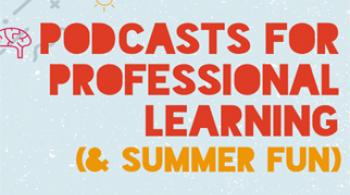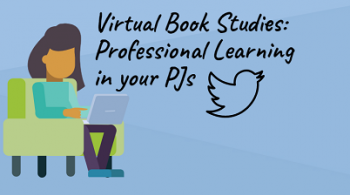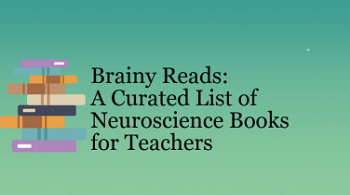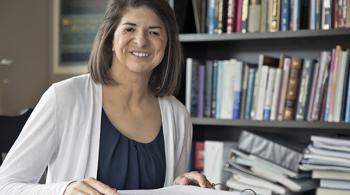By Erin Richmond, M.Ed., Fellow at the Center for Innovation and Leadership in Special Education at Kennedy Krieger Institute
April 18, 2017
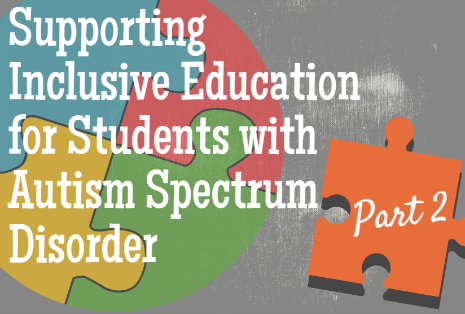
Welcome back! Here is PART II of the Inclusion Guide! Just to reiterate, the prevalence rate of autism spectrum disorder (ASD) is currently estimated to be one in sixty-eight (Centers for Disease Control and Prevention, 2014). The Least Restrictive Environment (LRE) under IDEA mandates that children with ASD should have the opportunity to be educated with typically-developing peers to the maximum extent possible. As a result, more students with autism are being included in the general education setting. There is no magic. The skillset and open mindedness of a teacher will help maximize success for students with autism in the inclusive setting. Here are some strategies for including children with autism in your classroom.
Behavior Supports
Neitzel (2010), explains “Engaging in disruptive and other challenging behaviors is not required for a diagnosis of autism; however, children and youth with autism spectrum disorders (ASD) are particularly at risk for developing at least one challenging behavior that interferes with their learning and development” (p. 247). Interfering behaviors could be repetitive, stereotypical behaviors (i.e., rocking, hand flapping, pacing, etc.) or disruptive behaviors (i.e., aggression, tantrums, etc.). Behaviors occur for a reason and serve a purpose or function. Teachers should use a positive, proactive approach to addressing behaviors in the classroom. Most importantly, collaborate with qualified individuals in the building and educate yourself on evidence-based strategies.
- Celebrate and build strengths and successes – Strive to give positive feedback more frequently than correction or negative feedback
- Preference Assessment – Conduct a preference assessment to determine which reinforcers will motivate the child
- Look for Triggers and Develop a Plan – Work with your school psychologist, behavior interventionist, and/or special educator for strategies on how to determine the function of the behavior and to implement strategies for replacing the behaviors. These qualified individuals can help conduct a Functional Behavioral Assessment (FBA) and develop a Behavior Intervention Plan (BIP).
- Implement the Behavior Intervention Plan – This plan is in place to provide a clear, consistent series of steps for addressing behaviors of concern within the school building
- Listen and Validate – The student’s emotions are real. Acknowledge how the child is feeling and provide a safe space to allow the child to share his fears, worries, or perceptions of an event that happened.
- Choices! – Koegel, Singh, and Koegel (2010) provided evidence that giving children choices related to their academic tasks improved several aspects of their performance. When given choices, the children initiated writing and math tasks more quickly, completed the tasks faster, decreased their disruptive behaviors, and demonstrated greater interest in the tasks.
- Clear, consistent expectations – Show or tell your student with autism what you expect using visuals, photographs, or video models
You are one of the biggest supporters in the life of a child who has autism. You have strategies to support a student with autism in communicating their interests, wants, and needs. You are familiar with proactive behavioral approaches for making a child available for learning and setting up them for success. You have ideas for fostering friendships and realizing the vitality that a student with autism brings to an inclusive classroom. Embrace the wondrous revelatory moments that await you and your student with autism. Not every day will be easy. Not every moment will go smoothly. However, if you embrace an inclusive mindset, believe in yourself and in your student with autism, and use this guide as a resource, I promise you will be in for a gratifying journey. In Part II of the Inclusion Guide, I will share strategies for classroom atmosphere and organization, seating alternatives, visual supports, transition strategies. In addition, I will share strategies for utilizing fascinations, areas of expertise, and strengths to enhance academic instruction, minimize anxiety, encourage friendships, and more.
Classroom Atmosphere and Organization
Some children with autism may have sensory processing deficits which is the inability to respond appropriately to ordinary experiences when the central nervous system processes sensations inefficiently. Wigham et al. (2015) explain that “sensory input can be experienced as heightened and unpleasant, or alternatively as reduced; and has been conceptualized as sensory under responsiveness or sensory over responsiveness to stimuli” (p.943). Lisa Carey, Education Consultant for Kennedy Krieger’s Center for Innovation and Leadership, wrote an informative blog post about designing inclusive classrooms! Check it out! Here are some additional strategies to consider using in the classroom to address sensory processing difficulties:
- Lighting – Lower levels of light, let child wear sunglasses or a hat, consider seating area, use color overlays, experiment with natural light
- Sound – Reduce classroom noise (carpet, tennis balls on chair and desk legs), use a soft voice, earplugs or headphones, change the sound (if a child does not like clapping you can introduce class to the sign for clapping in American Sign Language), allow the child to listen to music, look for ways to avoid exposing the child to loud noises, encourage self-advocacy
- Smells – Restrict use of perfumes and other related products, seat student near the door or a window
- Temperature – Encourage to dress in layers so they can adjust to the temperatures throughout the day, allow students to have a water bottle
- Be mindful that many children have effective ways for coping with problematic lighting, sounds, and smells. Pay attention to their strategies and avoid interfering if possible.
- Give everything a place
- Avoid visual overload
- Designate active learning areas – consider creating a “sit to learn” area and a “move to learn” (a child who paces could have a designated area that may be less distracting to other students)
Seating Alternatives
Imagine being on an airplane where you feel closed in and do not have enough leg room, ora meeting where you have to sit on a hard, metal chair for hours. No doubt you have felt some level of discomfort and were unable to pay attention to things going on around you. Consider this when organizing your classroom for a student with autism. Many of these seating choices may appeal to other students as well!
- Seating alternatives – Rocking chair, beanbag chair, couch, loveseat, exercise ball, Hoki stool, seating cushions, chair wedges, bungee chairs, resistance bands for chair legs
- Floor – Give students the option to work at their desk OR the floor (especially when working in groups or while working on a big project)
- Allow students to stand – Raise a table or desk to standing height for students
- Placement of desks or tables to promote learning and positive behavior
- Reduce distractions – Provide desktop study carrels or a quiet place for privacy and work when needed
- Create a homey retreat – Class pet(s), water feature, magazines/books, photo albums of students
- Set clear, consistent expectations if you provide a variety of seating options for your class.
Visuals, Visuals, Visuals!
A picture speaks a thousand words! Use them whenever and wherever you can. Visual supports help maintain a child’s focus and interest.
- Visual Parameters - Setting parameters involves using visuals to set clear boundaries around items or activities and to communicate basic expected behaviors, like waiting (i.e., using a stop sign to mark when an item or activity is available or not available)
- Visual schedules – Visual schedules increase predictability for students with autism. Schedules can be used to visually communicate upcoming events, facilitate transitions between activities, and increase student independence (Crosland & Dunlap, 2012).
Smooth Transitions
Hume et at., (2014) explain that “despite the routines that many teachers develop to facilitate efficient transitions and maximize instructional time, many learners with ASD continue to struggle with change during the day. As a result, these students require even more structure and thoughtful planning to be successful” (p. 35). The authors shared several steps to support transitions in the classroom.
- Step 1: Identify problematic transitions – Identify when, where, and with whom the challenging transitions occur
- Step 2: Select Appropriate Transition Supports
- Priming consists of allowing a student to preview information or activities before the student actually engages in that activity (i.e., preview future events such as a fire drill, substitute teacher, field trip, or rainy day schedule, so they become more predictable) (Crosland & Dunlap, 2012)
- Visual timers help students with ASD “see” how much time remains before an upcoming transition
- Visual countdown systems (i.e., 3-2-1 numbered countdown) helps a student “see” how much time is left without a specific time increment
- First-then charts with a sequence of two activities help some students with ASD better predict what will take place during the day
- Utilize apps and other resources (i.e., Pictello, iPrompts, Video Scheduler, Vis Timer, VoCal, to name a few)
- Read the full article to see pictures of examples!
- Step 3: Implementation of Supports – Determine how supports will be introduced and implemented (i.e., the roles, when it will be used, etc.)
- Step 4: Collect Data and Problem Solve for Successful Transitions – Use data to consider changes as needed, as well as create a fade plan if students are showing progress with transitions
Recognize and utilize student’s strengths and interests
Paula Kluth and Patrick Schwarz wrote “Just Give Him the Whale!”: 20 Ways to Use Fascinations, Area of Expertise, and Strengths to Support Students with Autism. Students with autism have fascinations, areas of expertise, and strengths can be used to learn standards-based content, develop social connections, minimize anxiety, expand communication skills, boost literacy learning and mathematics skills, and more. Here are a few wonderful ideas from this resource:
- Consider using a classroom theme related to student’s area of interest (i.e., if a child likes roller coasters then desks can be “cars,” assignments can be submitted to the “ticket window,” rules can be presented as “attention riders, please keep in mind a few rules for your safety and comfort …”)
- Find reading materials related to student’s fascinations, allow students to write about interests in a journal, involve favorite characters or objects in the act of reading or as part of math story problems
- Search curriculum for natural areas to teach about the student’s favorites (i.e., if a student loves vacuum cleaners, this topic can be featured in a unit on inventions)
- Review math curriculum to find any areas that might intersect well with students' interests (i.e., favorite foods to teach fractions, use a student’s name and favorite things in word problems, favorite foods or objects for one-to-one correspondence, etc.)
- Visit the UDL Digital Resource Roundup and UDL Classroom Materials Padlet for ideas for engaging and individualizing instruction all students, including those with autism!
In addition, remember to …
- Reject the deficit model and presume competence
- Seek professional development (Honestly Autism Day is a wonderful conference in the Baltimore area that is held annually
- Do not work in isolation and seek support from parents, special educators, behavior interventionists, school psychologist, etc.
- Try co-teaching with a special educator!
- Be creative and take risks
- Develop and maintain strong partnership with families
- Use evidence-based strategies
- Share the knowledge and encourage an inclusive school culture
For more inspiration on inclusive mindset, watch the following TED Talks on YouTube!
- The Power of Inclusion (Aaron DeVries)
- Every Child Needs a Champion (Rita Pierson)
Because of the tremendous diversity among students with autism, there is no “one-size-fits-all” strategy. The attitudes of the teacher can determine the success or failure of the student with ASD in the inclusive classroom. If teachers provide a nurturing environment, implement evidence-based strategies, and set suitable but challenging expectations, student with autism will thrive in the areas of socialization, communication, and academic achievement. Snow (2017) perfectly sums it up: The best way teachers can foster a love of school and learning in students with autism is to be “present, patient, and trusting – to learn from them what they need” (Snow, 2017, p. 30).
References:
Crosland, K., & Dunlap, G. (2012). Effective strategies for the inclusion of children with autism in general education classrooms. Behavior Modification, 36(3), 251-269.
Dawson, H. & LaRon, S. (2013). Teaching students with disabilities efficacy scale: development and validation. Inclusion, 1(3). 181-196.
Hume, K., Sreckovic, M., Snyder, K., & Carnahan, C. (2014). Smooth transitions: Helping students with autism spectrum disorder navigate the school day. Teaching Exceptional Children, 47(1), 35-45.
Kluth, P., & Schwarz, P. (2012). "Just give him the whale!": 20 ways to use fascinations, areas of expertise, and strengths to support students with autism. Baltimore, MD: Paul H. Brookes Publishing.
Kluth, P. (2010). “You’re going to love this kid!”: Teaching students with autism in the inclusive classroom. Baltimore, MD: Paul H. Brookes Publishing.
Koegel L, Singh A & Koegel R. (2010). Improving motivation for academics in children with autism. Journal of Autism and Developmental Disorders, 40, 1057-1066.
Maich, K. & Belcher, C. (2012). Using picture books to create peer awareness about autism spectrum disorders in the inclusive classroom. Intervention in School and Clinic, 47(4), 206-213.
Myles, B.S., Trautman, M.L. & Schelvan, R.S. (2004). The hidden curriculum: Practical solutions for understanding unstated rules in social situations. Shawnee Mission, KS: Autism Asperger Publishing Company.
Neitzel, J. (2010). Positive behavior supports for children and youth with autism spectrum disorders. Preventing School Failure, 54(4), 247-255.
Prevalence of Autism Spectrum Disorder Among Children Aged 8 Years – Autism and Developmental Disabilities Monitoring Network, 11 Sites, United States, 2010. (2014, March 28). Retrieved March 18, 2017, from https://www.cdc.gov/mmwr/preview/mmwrhtml/ss6302a1.htm
Snow, C. (2017). If you show up, they’ll surprise you. Educational Leadership, 74(7), 30-34.
Wigham, S., Rodgers, J., South, M., McConachie, H., & Freeston, M. (2015). The interplay between sensory processing abnormalities, intolerance of uncertainty, anxiety and restricted and repetitive behaviours in autism spectrum disorder. Journal of Autism Developmental Disorder, 45, 943-952.












